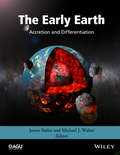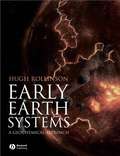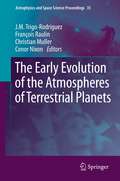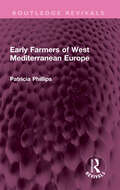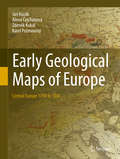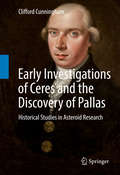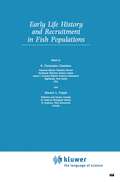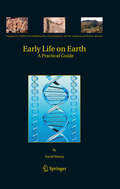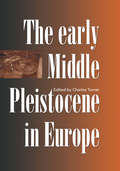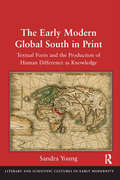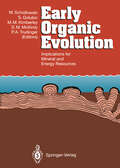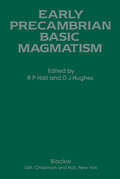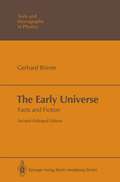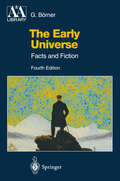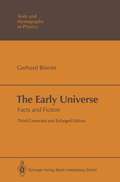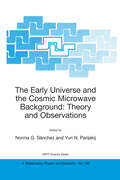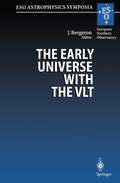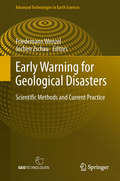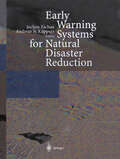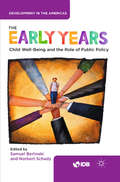- Table View
- List View
The Early Earth: Accretion and Differentiation (Geophysical Monograph Series)
by James Badro Michael J. WalterThe Early Earth: Accretion and Differentiation provides a multidisciplinary overview of the state of the art in understanding the formation and primordial evolution of the Earth. The fundamental structure of the Earth as we know it today was inherited from the initial conditions 4.56 billion years ago as a consequence of planetesimal accretion, large impacts among planetary objects, and planetary-scale differentiation. The evolution of the Earth from a molten ball of metal and magma to the tectonically active, dynamic, habitable planet that we know today is unique among the terrestrial planets, and understanding the earliest processes that led to Earth’s current state is the essence of this volume. Important results have emerged from a wide range of disciplines including cosmochemistry, geochemistry, experimental petrology, experimental and theoretical mineral physics and geodynamics. The topics in this volume include: Condensation of primitive objects in the solar nebula, planetary building blocks Early and late accretion and planetary dynamic modeling Primordial differentiation, core formation, Magma Ocean evolution and crystallization This volume will be a valuable resource for graduate students, academics, and researchers in the fields of geophysics, geochemistry, cosmochemistry, and planetary science.
Early Earth Systems: A Geochemical Approach
by Hugh R. RollinsonEarly Earth Systems provides a complete history of the Earth from its beginnings to the end of the Archaean. This journey through the Earth's early history begins with the Earth's origin, then examines the evolution of the mantle, the origin of the continental crust, the origin and evolution of the Earth's atmosphere and oceans, and ends with the origin of life. Looks at the evidence for the Earth's very early differentiation into core, mantle, crust, atmosphere and oceans and how this differentiation saw extreme interactions within the Earth system. Discusses Archaean Earth processes within the framework of the Earth System Science paradigm, providing a qualitative assessment of the principal reservoirs and fluxes in the early Earth. “The book would be perfect for a graduate-level or upper level undergraduate course on the early Earth. It will also serve as a great starting point for researchers in solid-Earth geochemistry who want to know more about the Earth’s early atmosphere and biosphere, and vice versa for low temperature geochemists who want to get a modern overview of the Earth’s interior.” Geological Magazine, 2008
The Early Evolution of the Atmospheres of Terrestrial Planets (Astrophysics and Space Science Proceedings #35)
by J. M. Trigo-Rodriguez, François Raulin, Christian Muller and Conor Nixon“The Early Evolution of the Atmospheres of Terrestrial Planets” presents the main processes participating in the atmospheric evolution of terrestrial planets. A group of experts in the different fields provide an update of our current knowledge on this topic. Several papers in this book discuss the key role of nitrogen in the atmospheric evolution of terrestrial planets. The earliest setting and evolution of planetary atmospheres of terrestrial planets is directly associated with accretion, chemical differentiation, outgassing, stochastic impacts, and extremely high energy fluxes from their host stars. This book provides an overview of the present knowledge of the initial atmospheric composition of the terrestrial planets. Additionally it includes some papers about the current exoplanet discoveries and provides additional clues to our understanding of Earth’s transition from a hot accretionary phase into a habitable world. All papers included were reviewed by experts in their respective fields.We are living in an epoch of important exoplanet discoveries, but current properties of these exoplanets do not match our scientific predictions using standard terrestrial planet models. This book deals with the main physio-chemical signatures and processes that could be useful to better understand the formation of rocky planets.
Early Farmers of West Mediterranean Europe (Routledge Revivals)
by Patricia PhillipsOriginally published in 1975, this book traces the subsistence methods of Mediterranean country dwellers from the mid-seventh millennium B. C. (in radio-carbon year) to the beginning of the Bronze Age. It illustrates the change from Mesolithic to Neolithic cultures over a wide area: (South of France, Italy, Corsica, Sardinia and Spain). The book explores the human societies that lived through this important period of change and adaptation. From their density of settlement, site locations and material culture, hypotheses can be made as to population size and structure. There are sufficient clues in the archaeological record to make possible very cogent comparisons between the hunter-gatherers of the pre-pottery era in West Mediterranean Europe and their distant descendants on the eve of the Bronze Age. How these changes came about, and their effect on Neolithic people as individuals and members of human society form the central part of the book.
Early Farmers of West Mediterranean Europe (Routledge Revivals)
by Patricia PhillipsOriginally published in 1975, this book traces the subsistence methods of Mediterranean country dwellers from the mid-seventh millennium B. C. (in radio-carbon year) to the beginning of the Bronze Age. It illustrates the change from Mesolithic to Neolithic cultures over a wide area: (South of France, Italy, Corsica, Sardinia and Spain). The book explores the human societies that lived through this important period of change and adaptation. From their density of settlement, site locations and material culture, hypotheses can be made as to population size and structure. There are sufficient clues in the archaeological record to make possible very cogent comparisons between the hunter-gatherers of the pre-pottery era in West Mediterranean Europe and their distant descendants on the eve of the Bronze Age. How these changes came about, and their effect on Neolithic people as individuals and members of human society form the central part of the book.
Early Geological Maps of Europe: Central Europe 1750 to 1840
by Jan Kozák Alena Čejchanová Zdeněk Kukal Karel PošmournýThis book focuses on the presentation and evaluation of geological maps of the Central Europe from 1750 up to 1840. Milestones in presentation of stratigraphy and tectonics and new geological models on such maps will be underlined. Map descriptions contain fundamentals editorial data as well as the map author’s affiliation and biographies. It represents for the region of the Central Europe the first work of this type. Geological maps represent geological synthesis and indicate the level of geological knowledge throughout history. They serve as guidelines for an economic utilization of mineral deposits and further geological investigation.
Early Investigations of Ceres and the Discovery of Pallas: Historical Studies in Asteroid Research
by Clifford CunninghamAn asteroid scholar, Cunningham in this book picks up where his Discovery of the First Asteroid, Ceres left off in telling the story of the impact created by the discovery of this new class of object in the early 1800s. The best and brightest minds of mathematics, science, and philosophy were fascinated by Ceres, and figures as diverse as Gauss, Herschel, Brougham, Kant, and Laplace all contributed something to the conversation. The first few chapters deal with the mathematical and philosophical aspects of the discovery, and the rivalry between Germany and France that so affected science and astronomy of that era. The jockeying for glory over the discovery of Ceres by both Piazzi and Bode is examined in detail, as is the reception given to Herschel’s use of the word 'asteroid.' Archival research that reveals the creator of the word 'asteroid' is presented in this book. Astronomy was a truly cosmopolitan field at the time, spanning across various disciplines, and the discovery of Pallas, a story completely told in these pages, exemplifies the excitement and drama of early 1800s astronomy. All the private correspondence about the study of Ceres and Pallas in 1802 is given here, which helps to contextualize and personalize the discovery.
Early Life History and Recruitment in Fish Populations (Fish & Fisheries Series #21)
by R. C. Chambers Edward A. TrippelMany of the processes influencing recruitment to an adult fish population or entry into a fishery occur very early in life. The variations in life histories and behaviours of young fish and the selective processes operating on this variation ultimately determine the identities and abundance of survivors. This important volume brings together contributions from many of the world's leading researchers from the field of fish ecology. The book focuses on three major themes of pressing importance in the analysis of the role that the early life history of fishes plays in the number and quality of recruits: the selective processes at play in their early life history; the contributions of early life history to the understanding of recruitment.
Early Life on Earth: A Practical Guide (Topics in Geobiology #31)
by David WaceyWhen did life first appear on Earth and what form did it take? The answer to this intriguing and fundamentally important question lies somewhere within the early Archean rock record. The young Earth was, however, a very different place to that we know today and numerous pitfalls await our interpretation of these most ancient rocks. The first half of this practical guide equips the reader with the background knowledge to successfully evaluate new potentially biological finds from the Archean rock record. Successive steps are covered, from locating promising samples in the field, through standard petrography and evaluation of antiquity and biogenicity criteria, to the latest state of the art geochemical techniques. The second half of the guide uniquely brings together all the materials that have been claimed to comprise the earliest fossil record into an easily accessible, fully illustrated format. This will be a handbook that every Archean geologist, palaeobiologist and astrobiologist will wish to have in their backpack or on their lab-bench.
The Early Middle Pleistocene in Europe
by Charles TurnerThese papers show how new research in the classic areas and Germany, but particularly in Eastern Europe, is radically altering views of the stratigraphy and palaeocology of the early-middle Pleistocene period, showing that major glaciations did not begin only in the late- middle Pleistocene.
The Early Middle Pleistocene in Europe
by Charles TurnerThese papers show how new research in the classic areas and Germany, but particularly in Eastern Europe, is radically altering views of the stratigraphy and palaeocology of the early-middle Pleistocene period, showing that major glaciations did not begin only in the late- middle Pleistocene.
The Early Modern Global South in Print: Textual Form and the Production of Human Difference as Knowledge
by Sandra YoungEarly modern geographers and compilers of travel narratives drew on a lexicon derived from cartography’s seemingly unchanging coordinates to explain human diversity. Sandra Young’s inquiry into the partisan knowledge practices of early modernity brings to light the emergence of the early modern global south. Young proposes a new set of terms with which to understand the racialized imaginary inscribed in the scholarly texts that presented the peoples of the south as objects of an inquiring gaze from the north. Through maps, images and even textual formatting, equivalences were established between ’new’ worlds, many of them long known to European explorers, she argues, in terms that made explicit the divide between ’north’ and ’south.’ This book takes seriously the role of form in shaping meaning and its ideological consequences. Young examines, in turn, the representational methodologies, or ’artes,’ deployed in mapping the ’whole’ world: illustrating, creating charts for navigation, noting down observations, collecting and cataloguing curiosities, reporting events, formatting materials, and editing and translating old sources. By tracking these methodologies in the lines of beauty and evidence on the page, we can see how early modern producers of knowledge were able to attribute alterity to the ’southern climes’ of an increasingly complex world, while securing their own place within it.
The Early Modern Global South in Print: Textual Form and the Production of Human Difference as Knowledge (Literary And Scientific Cultures Of Early Modernity Ser.)
by Sandra YoungEarly modern geographers and compilers of travel narratives drew on a lexicon derived from cartography’s seemingly unchanging coordinates to explain human diversity. Sandra Young’s inquiry into the partisan knowledge practices of early modernity brings to light the emergence of the early modern global south. Young proposes a new set of terms with which to understand the racialized imaginary inscribed in the scholarly texts that presented the peoples of the south as objects of an inquiring gaze from the north. Through maps, images and even textual formatting, equivalences were established between ’new’ worlds, many of them long known to European explorers, she argues, in terms that made explicit the divide between ’north’ and ’south.’ This book takes seriously the role of form in shaping meaning and its ideological consequences. Young examines, in turn, the representational methodologies, or ’artes,’ deployed in mapping the ’whole’ world: illustrating, creating charts for navigation, noting down observations, collecting and cataloguing curiosities, reporting events, formatting materials, and editing and translating old sources. By tracking these methodologies in the lines of beauty and evidence on the page, we can see how early modern producers of knowledge were able to attribute alterity to the ’southern climes’ of an increasingly complex world, while securing their own place within it.
Early Organic Evolution: Implications for Mineral and Energy Resources
by Philip A. Trudinger Manfred Schidlowski Stjepko Golubic Michael M. Kimberley David M. McKirdyThis volume is the final outcome of a conference designed to wrap up IOCP Project 157 (" Early Organic Evolution and Mineral and Energy Resources ") after a decade of prolific activity. The picturesque solitude of Maria Laach Abbey in the Eifel Mountains (FRO) provided the appropriate setting for a conclave of some 80 specialists from the various walks of the field who, during the week of Sept. 19 - 23, 1988, strived hard to define the state of the art in the principal segments of this Earth Science frontier. The following pages contain the essence of the conference transactions, giv ing a vivid cross-section of the activities pursued by IOCP Project 157 during its final years. The coverage of topics is not necessarily complete, but rather eclec tic in part. With regard to single papers dealing with modern analogues of ancient processes, the book title might even be considered a grave misnomer. Neverthe less, all contributions relate to the subject in the widest sense, and the reader should be reminded that much of the heterogeneity reflected by the volume de rives from the fact that it is primarily a research report from a highly inter disciplinary field rather than a textbook.
Early Precambrian Basic Magmatism
by R.P. Hall D.J. HughesBasic magmatic rocks make up approximately three-quarters of the crust ofthe present day Earth. Because we can observe and study the volcanic products of present day tectonic regimes comprehensively, we can shed light on ancient tectono-magmatic provinces, and thereby deduce the petrogenesis and evolution of the oldest basic rocks. This is the primary objective of this book. The book was conceived in order to provide a comprehensive review of the basic rocks produced during the first half of the Precambrian, i.e. the Archaean and early Proterozoic, to about 1.8 Ga years ago. Two major questions are addressed. First, what basic magmas were generated during the early Precambrian: were these magmas globally uniform, and to what extent were prevailing tectonic controls and compo sitions analogous to those of the present day? Clearly, this can be answered only by bringing together fundamental information about all relevant basic magmatic events. Second, is there any systematic temporal variation in the nature of basic suites, and what implications might such variations have on our interpretations of early Earth history? Are there important differences between early Archaean, late Archaean, Proterozoic and modern basic magmatic suites? The book uses two approaches to address these questions. Early chapters examine the fundamental characteristics of these basic rocks, whilst later chapters assess regional distribution and development by providing an overview of each major early Precambrian craton.
The Early Universe: Facts and Fiction (Theoretical and Mathematical Physics)
by Gerhard BörnerConnections developed in recent years between particle physics and cosmologyare the focus of attention in this new textbook. The author describes some of the theories which have been developed to describe the fundamental interaction of elementary particles in the extremely high temperatures of the early universe, taking care to distinguish facts and well-established results from hypotheses and speculations. - The three parts of the book discuss the standard hot big bang model of the earlyuniverse, the basic ideas of the standard and the grand unified theories of elementary particles, and the influence of dark matter on the large-scale evolution of structure. In addition to making some minorcorrections the author has added an appendix presenting new results and an updated bibliography. Two main groups of readers are addressed: research students in astronomy can use this book to understand the impact of elementary particle theory on cosmology, while research students in particle physics can use it to acquaint themselves with the basic facts of cosmology. The book is written carefully enough to appeal also to a wider audience of physicists.
The Early Universe: Facts and Fiction (Astronomy and Astrophysics Library)
by Gerhard BörnerThis fourth edition of Börner's "The Early Universe" is practically a new book, not just updated version. In particular, it is now organized so as to make it more useful as a textbook. And problem sections are also added. In the centre are the connections between particle physics and cosmology: The standard model, some basic implications of quantum field theory and the questions of structure formation. Special emphasis is given to the observed anisotropies of the cosmic microwave background and the consequences drawn for cosmology and for the structure formation models. Nuclear and particle physicists and astrophysicists, researchers and teachers as well as graduate students will welcome this new edition of a classic text and reference.
The Early Universe: Facts and Fiction (Theoretical and Mathematical Physics)
by Gerhard BörnerIn this corrected and enlarged edition of Börner's well respected textbook, you will find an up-to-date account of the interplay between particle physics and astrophysics upon which modern cosmology is founded. The author describes some of the theories which have been developed to model the fundamental interaction of elementary particles in the extremely high temperatures of the early universe, taking care to distinguish facts and well- established results from hypotheses and speculations. The three parts of the book discuss the standard hot big bang model of the early universe, the basic ideas of the standard and the grand unified theories of elementary particles, and the influence of dark matter of the large- scale evolution of structure. In addition to making some minor corrections, the author has added an appendix presenting new results and an updated bibliography. Two main groups of readers are addressed: research students in astronomy can use this book to understand the impact of elementary particle theory on cosmology, while research students in particle physics can use it to acquaint themselves with the basic facts of cosmology. The book is written carefully enough to appeal also to a wider audience of physicists.
The Early Universe and the Cosmic Microwave Background: Theory and Observations (NATO Science Series II: Mathematics, Physics and Chemistry #130)
by Norma G. Sànchez Yuri N. ParijskijThe goal of the Daniel Chalonge School on Astrofundamental Physics is to contribute to a theory of the universe (and particularly of the early universe) up to the marks, and at the scientific height of, the unprecedented accuracy, existent and expected, in the observational data. The impressive development of modern cosmology during the last decades is to a large extent due to its unification with elementary particle physics and quantum field theory. The cross-section between these fields has been increasing setting up Astrofundamental Physics. The early universe is an exceptional (theoretical and experimental) laboratory in this new discipline. This NATO Advanced Study Institute provided an up dated understanding, from a fundamental physics and deep point of view, of the progress and key issues in the early universe and the cosmic microwave background: theory and observations. The genuine interplay with large scale structure formation and dark matter problem were discussed. The central focus was placed on the cosmic microwave background. Emphasis was given to the precise inter-relation between fundamental physics and cosmology in these problems, both at the theoretical and experimental/observational levels, within a deep and well defined programme which provided in addition, a careful interdisciplinarity. Special sessions were devoted to high energy cosmic rays, neutrinos in astrophysics, and high energy astrophysics. Deep understanding, clarification, synthesis, careful interdisciplinarity within a fundamental physics framework, were the main goals of the course.
The Early Universe with the VLT: Proceedings of the ESO Workshop Held at Garching, Germany, 1–4 April 1996 (ESO Astrophysics Symposia)
by Jacqueline BergeronThis is the second ESO workshop in aseries dedicated to science oppor tunities with the VLT. At the first workshop all areas of astronomical research were discussed. This second workshop is dedicated to research projects on the early Universe and has provided a forum for discussing strategies for studying faint distant objects in the optical and infrared spectral regions. This field is evolving very rapidly. There are several new surveys of galax ies and clusters of galaxies at intermediate redshift and quasars at very high redshift. Major advances in the morphological studies of distant galaxies, surveys of galaxies at high redshift and searches for primeval galaxies have been rendered possible by the new facilities provided by the Rubble Space Telescope and the Keck Telescope. Observational constraints on the evolution and formation of galaxies and large-scale structures as well as the cosmic chemical evolution were criti cally discussed with regard to theory and numerical simulations. In this context, the VLT first generation instrument capabilities were presented comprehensively and their use as cosmological tools discussed . The concluding remarks of the workshop focussed on the analysis of var ious possibilities for the VLT second generation instrumentation. Many of these topics were covered by invited reviews and talks, as well as some contributed talks. They are included in this volume together with the poster papers.
Early Warning for Geological Disasters: Scientific Methods and Current Practice (Advanced Technologies in Earth Sciences)
by Friedemann Wenzel Jochen ZschauThe past years have seen new technologies that could be utilized for early warning and real-time loss estimation. They include self-organizing sensor networks, new satellite imagery with high resolution, multi-sensor observational capacities, and crowd sourcing. From this and improved physical models, data processing and communication methodologies a significant step towards better early warning technologies has been achieved by research.At the same time, early warning systems became part of the disaster management practice for instance in Japan and Indonesia. This book marks the important point where:Research activities continue to improve early warning Experience with applications is expandingAt this critical point in development of early warning for geological disasters it is timely to provide a volume that documents the state-of-the-art, provides an overview on recent developments and serves as knowledge resource for researcher and practitioners.
Early Warning Systems for Natural Disaster Reduction
by Jochen Zschau Andreas N. KüppersWritten for a broad audience this book offers a comprehensive account of early warning systems for hydro meteorological disasters such as floods and storms, and for geological disasters such as earthquakes. One major theme is the increasingly important role in early warning systems played by the rapidly evolving fields of space and information technology. The authors, all experts in their respective fields, offer a comprehensive and in-depth insight into the current and future perspectives for early warning systems. The text is aimed at decision-makers in the political arena, scientists, engineers and those responsible for public communication and dissemination of warnings.
The Early Years: Child Well-Being and the Role of Public Policy
by Inter-American Development Bank Norbert SchadyThis book is open access under a CC BY-NC-ND 3.0 IGO license. The Early Years analyzes the development of Latin American and Caribbean children and makes a compelling case for government intervention in what is instinctively a family affair. Spending on effective programs for young children is an investment that, if done well, will have very high returns, while failure to implement such programs will lower the returns on the hefty investments being made in primary, secondary, and higher education. Policies for young children belong at the core of a country's development agenda, alongside policies to develop infrastructure and strengthen institutions. However, if the services provided (or funded) by governments are to benefit children, they must be substantially better than what is currently being delivered in the region. This book offers suggestions for improving public policy in this critical area.
Earned Citizenship
by Michael J. SullivanThe migration and settlement of 11 million unauthorized immigrants is among the leading political challenges facing the United States today. The majority of unauthorized immigrants in the U.S. have been here for more than five years, and are settling into American communities, working, forming families, and serving in the military, even though they may be detained and deported if they are discovered. An open question remains as to what to do about unauthorized immigrants who are already living in the United States. On one hand it is important that the government sends a message that future violations of immigration law will not be tolerated. On the other sits a deeper ethical dilemma that is the focus of this book: what do the state and citizens owe to unauthorized immigrants who have served their adopted country? Earned Citizenship argues that long-term unauthorized immigrant residents should be able to earn legalization and a pathway to citizenship through service in their adopted communities. Their service would act as restitution for immigration law violations. Military service in particular would merit naturalization in countries with a strong citizen-soldier tradition, including the United States. The book also considers the civic value of caregiving as a service to citizens and the country, contending that family immigration policies should be expanded to recognize the importance of caregiving duties for dependents. This argument is part of a broader project in political theory and public policy aimed at reconciling civic republicanism with a feminist ethic of care, and its emphasis on dependency work. As a whole, Earned Citizenship provides a non-humanitarian justification for legalizing unauthorized immigrants based on their contributions to citizens and institutions in their adopted nation.
Earned Citizenship
by Michael J. SullivanThe migration and settlement of 11 million unauthorized immigrants is among the leading political challenges facing the United States today. The majority of unauthorized immigrants in the U.S. have been here for more than five years, and are settling into American communities, working, forming families, and serving in the military, even though they may be detained and deported if they are discovered. An open question remains as to what to do about unauthorized immigrants who are already living in the United States. On one hand it is important that the government sends a message that future violations of immigration law will not be tolerated. On the other sits a deeper ethical dilemma that is the focus of this book: what do the state and citizens owe to unauthorized immigrants who have served their adopted country? Earned Citizenship argues that long-term unauthorized immigrant residents should be able to earn legalization and a pathway to citizenship through service in their adopted communities. Their service would act as restitution for immigration law violations. Military service in particular would merit naturalization in countries with a strong citizen-soldier tradition, including the United States. The book also considers the civic value of caregiving as a service to citizens and the country, contending that family immigration policies should be expanded to recognize the importance of caregiving duties for dependents. This argument is part of a broader project in political theory and public policy aimed at reconciling civic republicanism with a feminist ethic of care, and its emphasis on dependency work. As a whole, Earned Citizenship provides a non-humanitarian justification for legalizing unauthorized immigrants based on their contributions to citizens and institutions in their adopted nation.
